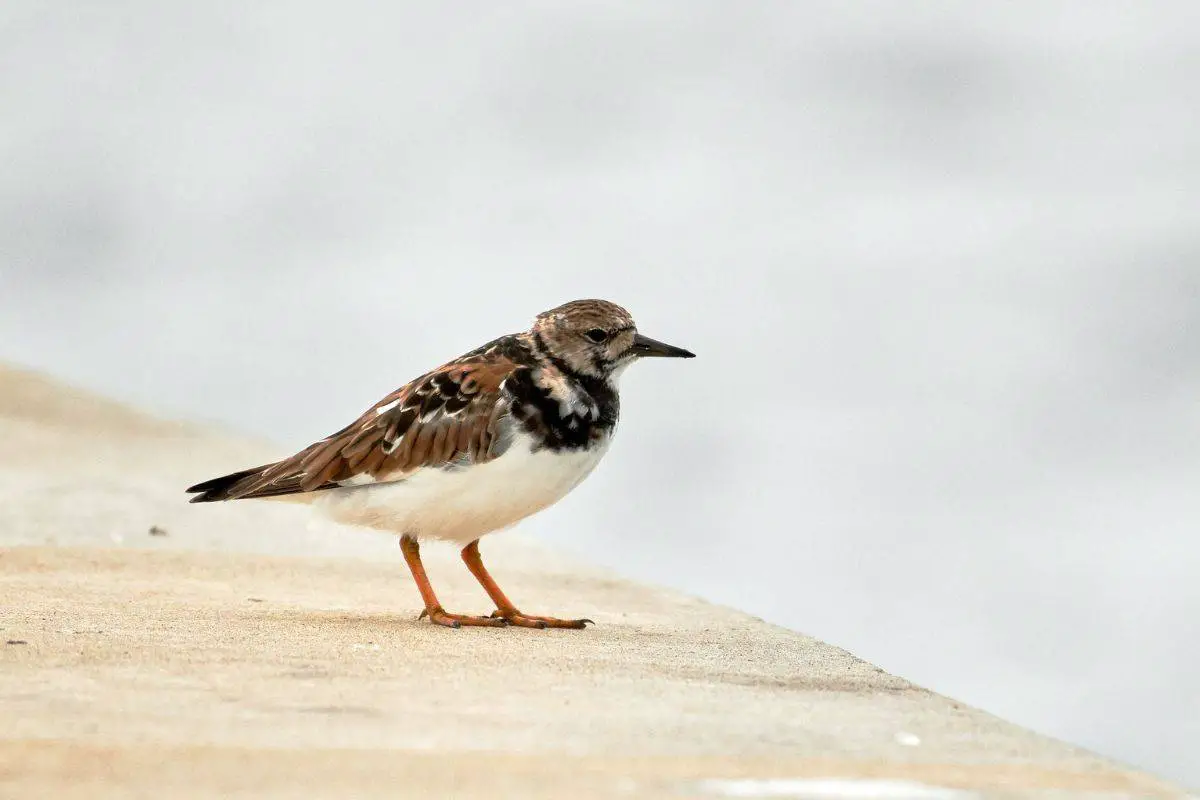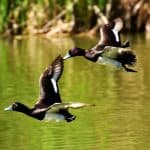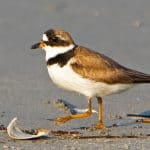Common Name: Ruddy Turnstone
Scientific Name: Arenaria interpres| Size | Diet | Range in Hawaii | Status in Hawaii |
|---|---|---|---|
| 8 in. - 10 in. | crabs, amphipods, and sandhoppers | Common on all islands | Least Concern |
The Ruddy Turnstone (Arenaria interpres) is a small, stout shorebird with a unique black and chestnut breeding plumage that makes it easily recognizable. This bird species is a long-distance migrant, breeding in the high arctic tundra and wintering along the coasts of North and Central America, Europe, Africa, and Australia.
The Ruddy Turnstone is also a common winter visitor to Hawaiʻi from August to May, making it a rare but exciting sight for birdwatchers and nature enthusiasts in the islands. In this article, we’ll take a closer look at the Ruddy Turnstone and explore its fascinating characteristics and behaviors.
Ruddy Turnstone
Appearance
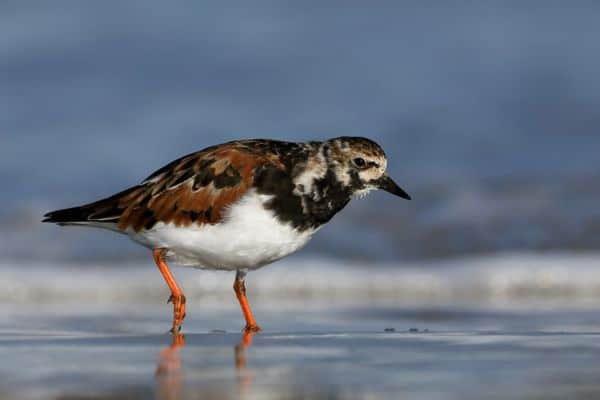
The Ruddy Turnstone is a medium-sized shorebird known for its distinct appearance and behavior. It measures approximately 8-10 inches in length, making it relatively compact.
This bird has a sturdy body with a short, thick neck and a slightly downcurved beak. Its plumage is eye-catching, displaying a mix of reddish-brown, black, white, and gray colors. During the breeding season, the adults exhibit brighter tones, enhancing their overall appeal.
Diet
The diet of the Ruddy Turnstone consists mainly of invertebrates found along coastal areas. These resourceful birds are known for their ability to flip stones and shells with their bills, exposing hidden prey. Their diet includes a variety of small crustaceans, such as crabs, amphipods, and sandhoppers. They also feed on marine worms, mollusks, and insects that inhabit the intertidal zone.
Ruddy Turnstones are opportunistic feeders and will often scavenge for food, taking advantage of carrion or leftover scraps from other animals. They are also known to eat plant material, including seeds and berries, particularly during their migration periods when coastal resources may be scarce. This adaptable diet allows them to thrive in a wide range of coastal habitats worldwide.
Nesting
The nesting behavior of the Ruddy Turnstone is characterized by its choice of breeding grounds and its nesting habits. These birds typically nest in the Arctic tundra regions, including parts of Alaska and northern Canada.
Ruddy Turnstones are ground nesters, meaning they construct their nests on the open ground. The female typically selects a well-concealed spot among vegetation or rocks to build the nest. The nest itself is a shallow depression lined with leaves, grass, moss, and other plant materials.
Breeding pairs are generally monogamous and both parents participate in nest construction and incubation. The female usually lays a clutch of 3-5 eggs, which are incubated for approximately 22-24 days. Both parents take turns incubating the eggs, with the male primarily responsible for nighttime incubation.
After hatching, the chicks are precocial, meaning they are able to leave the nest shortly after hatching and are capable of feeding themselves. The parents provide protection and guidance to the chicks, teaching them to forage for food and navigate their surroundings. The young turnstones gradually develop their flight feathers and independence before embarking on their migration to their wintering grounds.
Behavior
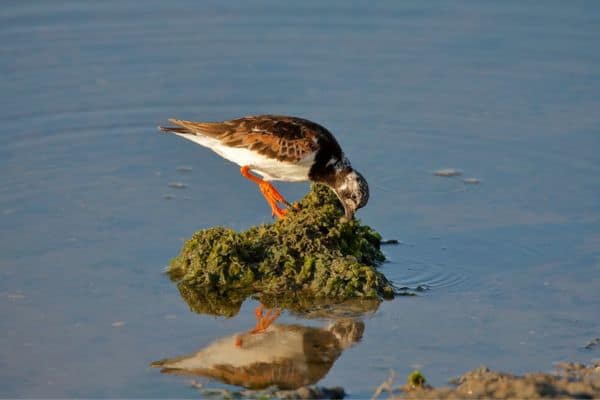
The Ruddy Turnstone is a shorebird known for its fascinating and active behavior. One notable aspect of their behavior is their skilled foraging technique.
These birds are adept at flipping over stones, shells, and other objects using their bills to expose hidden invertebrates like crustaceans, worms, and insects. It’s a sight to behold as they probe the sand or mud with their bills, tirelessly searching for prey.
Another remarkable behavior of the Ruddy Turnstone is its impressive migratory patterns. These birds embark on long-distance journeys, traveling between their breeding grounds in the Arctic and their wintering areas in coastal regions across the globe. They travel in flocks, navigating over land and sea to reach their destinations, covering vast distances that can span thousands of miles.
The Ruddy Turnstone’s behavior also includes engaging in social interactions with their own kind and other shorebirds. They can be seen forming tight-knit groups while foraging, migrating, or resting. These birds communicate with each other using various vocalizations, including calls and alarm signals.
Habitat
The Ruddy Turnstone is a shorebird that can be found in various coastal habitats across the globe. They inhabit both the Northern and Southern Hemispheres, depending on the season.
These birds are commonly found in rocky shores, sandy beaches, mudflats, and estuaries, where they have access to abundant food sources. They are particularly fond of intertidal zones, where they can forage for prey such as marine invertebrates and insects during low tide. During high tide, they seek refuge on higher ground to avoid being submerged.
During the breeding season, Ruddy Turnstones migrate to the Arctic tundra regions of Alaska, Canada, and other northern areas. Here, they choose nesting sites on the open ground, often near water bodies or amidst low-lying vegetation. The Arctic provides suitable conditions for their breeding and nesting requirements.
In the winter months, Ruddy Turnstones migrate to warmer coastal regions worldwide. They can be observed in a range of habitats during this time, including tropical beaches, mangroves, and coastal wetlands. These areas offer a milder climate and an ample food supply to sustain the birds throughout the winter.
Range
The Ruddy Turnstone has a notable presence in Hawaii as a wintering migrant and a stopover site during migration. It can be found across the Hawaiian Islands, including both the Northwestern Hawaiian Islands and the Southeastern Hawaiian Islands.
In the Northwestern Hawaiian Islands, Ruddy Turnstones have been recorded on islands such as Kure, Midway, Pearl and Hermes, French Frigate, Necker, and Nihoa. They are known to frequent coastal areas, wetlands, and ponds in the region.
In the Southeastern Hawaiian Islands, the Ruddy Turnstone has been observed on islands such as Ni’ihau, Kaua’i, O’ahu, Moloka’i, Maui, and Hawai’i Island. They can be found in a variety of habitats, including lawns, beaches, plowed areas, and upland pastures. Seasonal wetlands and ponds also attract Ruddy Turnstones, where they can be observed during their migration periods and as over-summering individuals.
Conservation Status
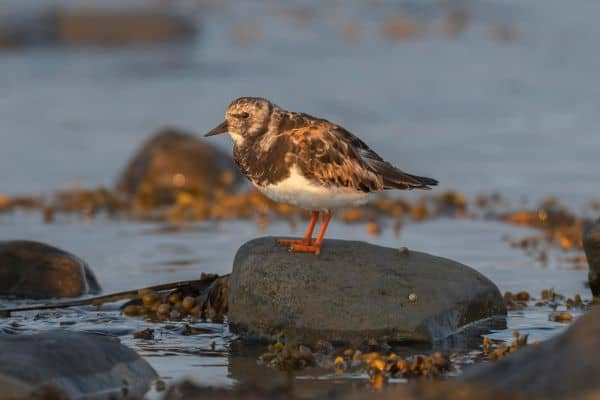
The conservation status of the Ruddy Turnstone is generally considered to be of least concern according to the International Union for Conservation of Nature (IUCN). This indicates that the species is not currently facing any major threats that would significantly impact its overall population.
While the Ruddy Turnstone is not considered globally threatened, it is important to note that local populations may face certain localized threats. These can include habitat loss or degradation due to coastal development, disturbance from human activities, and potential impacts from climate change, such as rising sea levels and changing weather patterns.
Interesting Facts
1. Courtship displays
Males perform courtship displays to attract females, involving various behaviors such as head bobbing, wing spreading, and vocalizations. These displays often include striking visual patterns and calls.
2. Social birds
Ruddy Turnstones are often seen in small to large flocks, particularly during migration and wintering periods. They may also gather with other shorebird species, such as Pacific Golden Plovers.
3. Unique feeding behavior
The Ruddy Turnstone exhibits a behavior called “turnstone flipping.” They flip over stones and shells to expose hidden prey beneath. This behavior is where their name “turnstone” originates.
4. Expert foragers
Ruddy Turnstones are highly skilled at finding food. They use their strong bills to overturn rocks, pebbles, and seaweed to uncover small invertebrates such as insects, crustaceans, mollusks, and marine worms.
5. Incredible migratory abilities
Ruddy Turnstones are known for their long-distance migrations. They have one of the longest migratory routes of any shorebird, traveling from their arctic breeding grounds to their wintering areas in a variety of countries and continents.
Frequently Asked Questions
1. Do Ruddy Turnstones breed in Hawaii?
No, Ruddy Turnstones do not breed in Hawaii. They breed in the Arctic regions of the northern hemisphere. However, they can be found in Hawaii during migration and winter months.
2. How long do Ruddy Turnstones live?
Ruddy Turnstones have an average lifespan of about 10-15 years in the wild. However, some individuals have been known to live for over 20 years.
3. Are Ruddy Turnstones vocal birds?
Yes, Ruddy Turnstones have a variety of vocalizations. They produce calls such as sharp “tew-tew-tew” notes during flight or for communication within their flock.
4. Can Ruddy Turnstones change their appearance?
Yes, the plumage of Ruddy Turnstones can vary between the breeding and non-breeding seasons. During the breeding season, their colors become brighter and more vibrant, while in winter, their plumage becomes mottled and predominantly gray.
